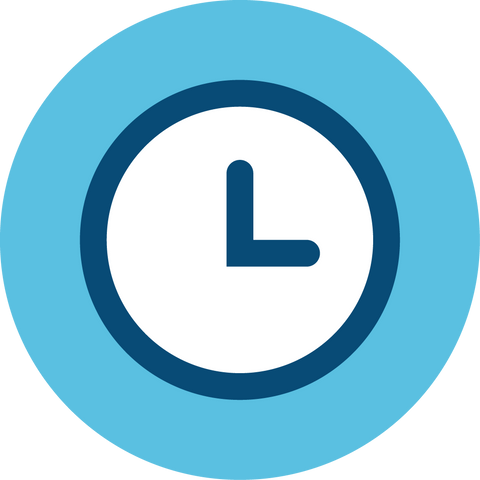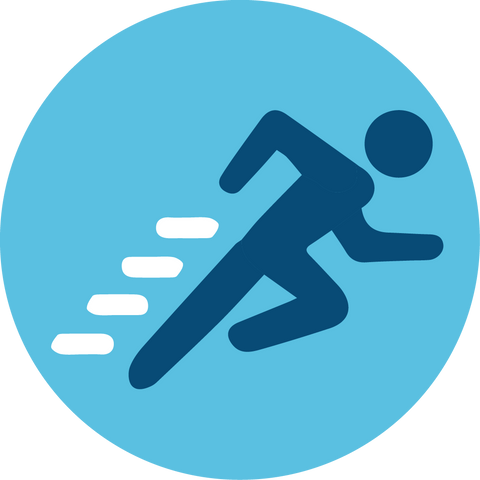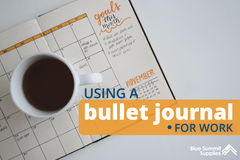Our leadership team at Blue Summit Supplies recently finished reading Doing Agile Right: Transformation Without Chaos by Darrell Rigby, Sarah Elk, and Steve Berez, and it inspired us to take a closer look at our business processes. Our minds are full of everything agile right now, but jumping headfirst into the world of agile has made us realize that for the uninitiated, there’s a lot of unique lingo surrounding agile, which is why we decided to create an agile cheat sheet.
Learn more about the agile methodology, including the pros and cons, the most common terms used in agile and Scrum, and a list of books to get you started.
Pros and Cons of Agile Methodology
When it comes to the pros and cons of agile, there’s not a whole lot we can say against agile. It’s an excellent methodology that can be applied to a wide variety of industries to improve team collaboration, alignment, efficiency, and flexibility. Honestly, one of the only major cons of agile is the complicated terminology that can take some time to get used to. 😅
Pros |
Cons |
|
● Helps teams become more adaptable ● Anticipate roadblocks before they occur ● Encourages a continuous improvement mindset ● Decisions are made based on stakeholder and customer needs (What drives the most value) ● Work in progress is managed to ensure work is evenly distributed, preventing team burnout ● Goals are reassessed throughout the project ● Everyone’s voice is heard ● Eliminates waste so your team can work at optimal efficiency |
● Complex terminology ● Challenging learning curve ● Difficult to scale across large enterprises ● Lack of a strict schedule can negatively impact productivity if not properly managed |
What is Agile?
First and foremost: no, agile does not refer to your personal flexibility or talent for sports and exercise. 🏃♀️ 🏃
The agile methodology promotes collaboration, efficiency, adaptability, and provides consistent value to customers and stakeholders through progressive iterations of productive work. Each iteration yields fresh insights into what’s working with the process and what isn’t, leading to actionable steps to improve the team’s process for the next iteration.

Agile has evolved quite a bit over the years, originally becoming popular in software development. Since then, it’s been applied to a number of different industries to improve workplace efficiency, optimize task management, align teams on goals, and drive a continuous improvement mindset.
The agile approach is multidimensional and flexible, enabling teams to adapt to changing circumstances or customer needs on the fly in order to deliver consistent value.
Agile Cheat Sheet
Use our agile terminology cheat sheet to get a better handle on all of that unique lingo.

Agile
Agile is an iterative approach to project management designed to enable teams to deliver consistent value to customers and stakeholders faster with fewer bottlenecks and roadblocks. Agile teams provide this consistent value by producing and delivering work in small, consumable increments. Instead of waiting to see how the customer feels after the project is completely finished, customers and stakeholders are brought inside the development process so that each iteration can be further tailored to exactly what they want or need.
Under agile, plans and requirements are continuously evaluated so that teams can respond to change quickly.

Lean
Lean is all about improving efficiency by eliminating waste. Any task that doesn’t bring direct value to the customer is considered wasteful, and it’s eliminated or reduced as much as possible. It’s a guiding methodology designed to help teams work more productively, efficiently, and effectively. Lean can be applied to a number of different agile methodologies and provides a framework to scale agile practices across large or growing organizations.
Though it originated in manufacturing with the Toyota Production System, lean is utilized in many different industries today. Visit the Lean Enterprise Institute to learn more.

Capacity
Capacity is a measurement of the total number of available hours for an upcoming sprint. The available hours are determined based on company resources, future planned holidays, etc.

Velocity
Velocity measures how many units of work can be completed within each iteration (or sprint if using Scrum.) It’s designed to help teams create accurate, efficient, and attainable timelines for the work to be completed.

Time-Box
A time-box is a set amount of time for an event or amount of work to be completed. The activity cannot last for longer than is allotted in the time-box. For example, a daily Scrum has a time-box of 15 minutes, which should be adhered to.

Stakeholder
Stakeholders are people outside of the Scrum team with a direct interest in or knowledge of the product or project (i.e., they’re usually commissioning it.) They are an active part of the process. Each time an increment of work or iteration is completed, it’s brought to the stakeholders to inspect during the sprint review. The stakeholders’ notes are then applied to the next iteration or sprint.

Sprint
A sprint is a short period of time in which a team works to complete a set amount of work. For example, a Scrum sprint is typically 2-4 weeks and includes four Scrum events (also known as rituals). The four events that make up a sprint are sprint planning, daily scrums (or stand-ups), sprint reviews, and sprint retrospectives.

Retrospective
A retrospective is a meeting that concludes a time-boxed event of productive work. It brings a team together to discuss what worked, what didn’t, and what can be improved for next time. Each retrospective should conclude with actionable steps to improve the next round of productive work.

Kanban
Kanban is one of the more simple agile processes that’s often applied within other agile processes (Scrum included.) It’s a task management tool that visually organizes all of the required work in order to optimize efficiency and limit work in progress. It’s designed to align everyone on the team or in the organization on action items so that everyone knows what the most important task of the day is.
A typical Kanban board is made up of three columns: To-Do, Doing, and Done. Tasks move forward through these columns as work progresses. In a physical workspace, a Kanban board is placed in a centralized location that’s visible to the entire team so that they can monitor everyone’s progress and align on action items. For remote or distributed teams, a Kanban board would take the form of an online resource that every team member can access, such as Trello.
Scrum
Scrum is a framework designed to help people, teams, and organizations create value through adaptive solutions for complex problems.

A Scrum is one sprint, which typically lasts for 2-4 weeks. At the beginning of a sprint, the product owner determines which tasks will move from the product backlog to the sprint backlog. The team, led by a Scrum Master, works to complete each task in the sprint backlog before the 2-4 weeks are up.
The Scrum team meets daily for stand-up meetings, where the team discusses any possible roadblocks standing in the way of progress and determines what should happen next. The Scrum process repeats until a product or project is complete or until the stakeholders are happy. At the end of each sprint, a sprint review and sprint retrospective are held so that the team can acquire feedback and discuss any successes and challenges as well as what can be improved for the next sprint.
Scrum Cheat Sheet
If you thought agile had complicated terminology, Scrum doubles down on it. Use our Scrum glossary as your own personal Scrum terminology cheat sheet.

Scrum Master
A Scrum Master facilitates and guides the team throughout the Scrum process. They are an expert in all things Scrum, acting as a servant leader who helps the team master the Scrum framework and improve with each sprint.

Scrum Master Checklist
A Scrum Master checklist is a comprehensive list of things the Scrum Master needs to check on to ensure the Scrum team has everything they need and is working completely within the Scrum framework.
Some checklist items might include:
- Are team members seeing continuous improvement? Are they happy with the process?
- Are stakeholders happy with the team and their progress?
- Is the team delivering based upon the previously agreed requirements?

Backlog
A backlog (also known as a product backlog) is utilized in Scrum. It consists of an ordered list of the work to be completed in order to create, maintain, and sustain a product or project. It’s managed by the product/project owner.

Sprint Backlog
At the beginning of each sprint, the product owner moves backlog items from the overall backlog to the sprint backlog. This makes a to-do list of sorts for the upcoming sprint. It provides an overview of the work that needs to be completed in order to achieve the sprint’s goal.

Backlog Refinement/Grooming
What is backlog grooming? Backlog refinement or grooming is an essential element of backlog management that makes sure the backlog always has the most up-to-date information. Grooming the backlog prioritizes work items so that the backlog is ready for the team at all times.
The focus of both Scrum and agile is on adaptability; plans need to evolve with new information, customer insights, or roadblocks. The priorities a team starts out with won’t necessarily remain the same throughout the process; backlog refinement ensures the backlog evolves with changing priorities and circumstances.

Sprint Planning
Sprint planning is a Scrum event time-boxed to eight hours or less. Every sprint starts with sprint planning. It brings the Scrum team together to discuss which tasks from the product backlog should be moved into the sprint backlog in order to be tackled next during the upcoming sprint.

Daily Scrum
A daily Scrum is a time-boxed event (typically not more than 15 minutes) held every day of the sprint to align team members on the goals of the next 24 hours and to discuss the work that was completed the previous day. It’s held at the same time and place each day to avoid confusion and keep things as streamlined as possible. By reviewing the work completed since the previous daily Scrum and the work to be completed in the next Scrum, the daily Scrum optimizes team collaboration and prevents roadblocks.

Sprint Review
A sprint review is a Scrum event that’s generally four hours or less used to conclude the work of a sprint. It brings the Scrum team and stakeholders together to review what was completed during the sprint, assess how the work completed contributes to the overall product or project goal, and update the product backlog.

Sprint Retrospective
A sprint retrospective is the Scrum event that officially ends a sprint. It brings the Scrum team together to discuss the highs and lows of the previous sprint to determine actionable steps to improve the next sprint.
Team members are generally asked some version of:
- What went well?
- What didn’t go so well?
-
What could be improved upon for next time?

Best Agile Books
We’re new to agile, which means we’ve been relying on a lot of helpful resources. Here are some popular books that will help you grasp the process of agile and improve your overall processes.
- Doing Agile Right: Transformation Without Chaos
- The Age of Agile
- Scrum: The Art of Doing Twice the Work in Half the Time
- The Scrum Princess
- Sprint: How to Solve Big Problems and Test New Ideas in Just Five Days
- Agile Retrospectives: Making Good Teams GreatSchwaber: 0852766001247
-
The Design of Everyday Things
More from Blue Summit Supplies
💡 Adaptability Training is the Key to Surviving the Future
💡 The Best Professional Development Books for Success
We’re always looking for new ways to improve workplace productivity and wellbeing. Follow our office supplies blogfor the latest trends, office strategies, product comparisons, and more.
If you have any questions or want to talk to someone about office supplies, email us or connect on Twitter, Facebook, or Instagram.
 For more informative articles about office supplies, subscribe to our email newsletter!
For more informative articles about office supplies, subscribe to our email newsletter!
Never fear, you won't begin receiving daily sales emails that belong in a spam folder. Instead, we promise a fun weekly roundup of our latest blog posts and great finds from across the web. And if you lose interest, it's always easy to unsubscribe with a single click.










